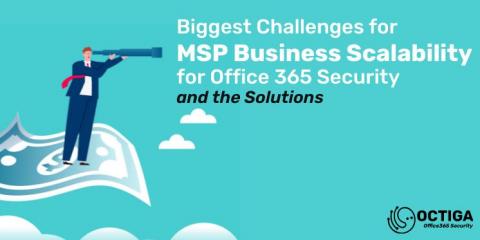Security | Threat Detection | Cyberattacks | DevSecOps | Compliance
Latest News
5 Ways Ransomware Can Negatively Impact Your Business
In the past year, virtually every day has brought news of another debilitating ransomware attack. And, in many of those attacks, there were key lessons that can be applied to companies like yours. This article will recap five real-life impacts of recent ransomware attacks. It will also provide best practices you can follow to prevent your organization from becoming a potential victim.
MSP Business Scalability Challenge for Office 365 Security
If we look at the industry report, the Managed Services Market is forecast to touch USD 557.10 billion by 2028. It has become a mature business now, however the customers' needs are highly complex when compared to traditional businesses. MSP Business opportunity/challenges can be complex to navigate, often involving multiple external market forces, internal drivers, organisational and client-based frictions, resistance to scaling, and of course, both financial and opportunity costs.
SQL Injection in Today's Landscape
A SQL injection flaw allows for an attacker to modify or inject SQL syntax into the request to make the application behave in a manner that was not initially intended. In other words, an attacker can change a database query to: Now with almost all web applications having integrations with databases in some way, this flaw has the potential to arise often. However, many frameworks and libraries are available to make database connections and queries safe.
Robot followers? The impact of social media bots
Social media has evolved to become much more than a simple platform to share thoughts and updates with the internet. Platforms such as Facebook, Twitter, and Instagram are frequently used for business, politics, news, and online events, in addition to their original purpose of social sharing.
How to Perform a Comprehensive Network Vulnerability Assessment
Despite growing awareness and prioritization of cybersecurity, close to 22,000 vulnerabilities were published in 2021 alone. This concerning number proves that awareness and a willingness to invest in cybersecurity aren’t always enough to protect your organization’s network, and that network vulnerability is far from a problem of the past. To protect your networks, you need to continually monitor and assess their potential vulnerabilities to guarantee security.
Cyber Security in 2021 - What Happened?
2021 was quite a year. Some things changed, and some things very much stayed the same. The world of cyber security was not immune to this zeitgeist, with some aspects of the threat landscape persisting and some rapidly changing and evolving. This piece will examine the key trends in the cybersecurity threat landscape that we saw over the last year.
How to Perform a Comprehensive Network Vulnerability Assessment
Despite growing awareness and prioritization of cybersecurity, close to 22,000 vulnerabilities were published in 2021 alone. This concerning number proves that awareness and a willingness to invest in cybersecurity aren’t always enough to protect your organization’s network, and that network vulnerability is far from a problem of the past. To protect your networks, you need to continually monitor and assess their potential vulnerabilities to guarantee security.
What the sysadmin misses, Desktop Central catches!
Most people are fairly good at reading, but not enough are good at reading between the lines. More often than not, there are certain things hidden in plain sight that may not catch your attention. The eyes of a system administrator are often glued to tasks like system maintenance and user administration. When engaged in many tasks at once, it is only human to overlook a few things like patch and antivirus updates, but it can cost an organization dearly in terms of data security.
Three things you should know about SASE and SD-WAN
As organizations have accelerated their plans to better enable dispersed workforces in a post-pandemic reality, many technology decision-makers are broadly rethinking their network architectures. Inevitably their discussions lead to comparisons and debates over both software-defined wide area network (SD-WAN) and secure access service edge (SASE) technologies.










